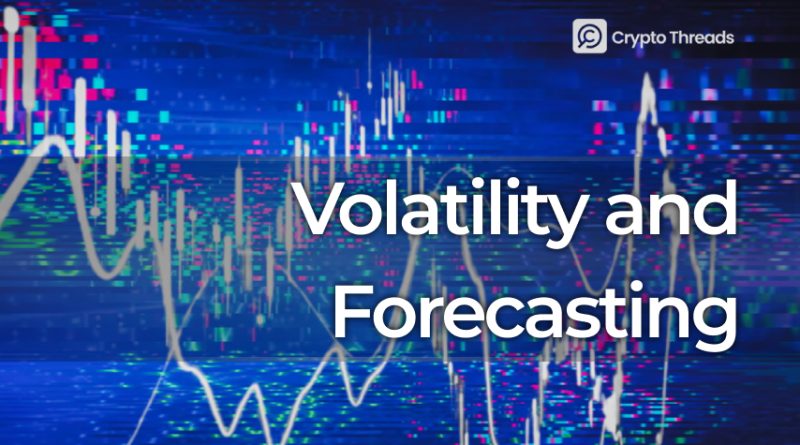Understanding Volatility and the Importance of Forecasting
In the increasingly turbulent financial markets, volatility and forecasting volatility have become a major aspect in making investment decisions. This article not only introduces the concept of volatility but also illustrates its importance in risk management, quantitative trading and asset valuation. Through this, we will also learn why forecasting volatility is considered a strategic tool in the financial industry.
What is Volatility?
Volatility is a measure of the change in the price of any asset over a certain period of time. It can be an increase or decrease in volatility. Volatility reflects the instability of the market and indicates the level of risk of an asset expressed through price changes but also related to investors’ sense of uncertainty about the future of the market.
To better understand volatility, we shall learn about different types of volatility below:
https://www.investopedia.com/terms/v/volatility.asp
Implied Volatility
Implied volatility (IV), also known as expected volatility, is one of the most important indicators for options traders. As the name suggests, IV helps them determine how volatile the market will be in the future.
This concept also provides traders with a way to calculate probabilities. However, it should be noted that IV is not considered an exact science, so it cannot predict the future direction of the market with certainty.
Unlike historical volatility, IV is derived from the price of the option contract and reflects expectations about future volatility. Because it is “implied”, traders cannot rely on past data to predict future volatility, but must rely on the ability to assess the potential of the option in the market.
Historical Volatility
Historical volatility, also known as statistical volatility, measures the volatility of the underlying security based on price changes over a given period of time. Compared to IV, HV is less desirable because it does not have the ability to predict the future.
When HV increases, it indicates that the security’s price fluctuates more than usual, signaling that a change is expected. Conversely, when HV decreases, it indicates that the volatility has resolved, and the market is gradually stabilizing. HV can be calculated based on intraday volatility, but it is usually measured by comparing closing prices between days. Depending on the time frame of the option, HV can be determined between 10 and 180 trading days.
Why Make Price Volatility Forecasts?
Price volatility forecasts
Price volatility is not simply an issue of how much the price moves up or down. It is really a great “assistant” for those who invest, trade or work in the financial field. Understanding how much or how little the price of an asset can change helps you manage your money more skillfully, choose the right trading method and avoid unnecessary risks. Below are some of the main reasons to see how important price fluctuation forecasting is in today’s financial world.
Risk Management
When trading in finance, risk is unavoidable, but you can manage it more effectively if you can predict price changes.
https://www.cryptothreads.blog/post/short-crypto-6-effective-strategies-and-key-risks-to-manage
Portfolio risk assessment
Forecasting fluctuations helps you know how fragile your portfolio is. If prices are about to fluctuate violently, the market can be chaotic and you are likely to lose money. Contrary, when things are calm, your assets are safer, but the opportunity to make big profits is also less. By being able to predict, you can make adjustments, such as buying less stocks and more bonds to keep things balanced.
Protecting capital when the market is volatile
When prices are volatile, you need precautions such as stop-loss orders or options to keep your money from flying away. But without accurate forecasting of volatility, these decisions will be ineffective. For example, if a trader sets a stop-loss too close in a period of high volatility, they may be taken out early due to random price movements. Conversely, if they set a stop-loss too far in a market with low volatility, they may incur a larger loss than they wanted before exiting the position.
Application in risk management models
Popular risk measurement models such as Value at Risk (VaR) and Conditional VaR (CVaR) require accurate volatility estimates to forecast the potential loss level in the investment portfolio. If volatility increases, VaR will signal a higher expected loss, from which the fund manager can take risk reduction measures such as rebalancing the portfolio, reducing the leverage ratio, or using financial hedging tools.
Quantitative Trading

In quantitative trading, volatility is a core factor that affects strategy, timing, and overall performance.
Building strategies based on volatility
Quantitative traders often use volatility to design appropriate strategies. When expected volatility increases, strategies such as straddles, strangles, or iron condors are used to exploit sharp price swings. Conversely, when volatility is low, strategies such as covered calls or iron butterflies are more effective because they focus on stable income.
You can refer to some strategies here https://www.cryptothreads.blog/post/10-crypto-options-trading-strategies-to-maximize-profits
Taking advantage of arbitrage opportunities
Differences in volatility between related assets (such as options with different maturities or derivatives of the same underlying asset) create arbitrage opportunities. Quantitative funds can exploit this difference through statistical arbitrage or volatility arbitrage, buying and selling contracts to profit from the expectation of uneven volatility.
Market Making and Spread Management
Market makers rely on volatility forecasts to adjust spreads. When volatility is high, they widen spreads to reduce the risk of price manipulation; when volatility is low, they narrow spreads to encourage trading, optimize profits, and control risk.
Option pricing
Volatility is the most important factor in option pricing, directly affecting contract prices and trading strategies.
Role in the Black-Scholes model
The Black-Scholes model and related models such as binomial trees use volatility as the main parameter for pricing options. High volatility increases option prices due to the possibility of a contract being in-the-money. Conversely, when volatility is low, option prices fall because the underlying asset is less likely to swing wildly away from the strike price.
( https://www.investopedia.com/terms/b/blackscholes.asp )
Optimizing options trading strategies
Option traders rely on volatility to adjust their strategies. When volatility is expected to increase, they can buy calls or puts to take advantage of large swings. If volatility decreases, they can sell options to collect premiums in a stable market.
Evaluating the probability of exercising an option
Volatility affects the likelihood of an option being exercised before expiration. High volatility widens the range of expected asset prices, increasing the chance that the option will be worth money at expiration. This is important in choosing the right strike price to maximize profits.
Conclusion
Volatility forecasting is an important tool in finance, helping to manage risks, optimize trading strategies and price assets. Investors use volatility to assess risks, adjust portfolios, take advantage of market fluctuations and accurately price options, thereby making effective trading decisions.
In the next article, we will explore in more depth the methods of volatility forecasting, from traditional statistical models such as ARCH, GARCH to advanced machine learning techniques such as LSTM, Transformer. Each method has its own advantages and disadvantages, and choosing the right method depends on the characteristics of the market as well as the goals of the investor.
Hopefully this article has provided an overview and details of the importance of volatility in finance. If you have any questions or want to discuss more about specific applications, let’s discuss to understand better!



